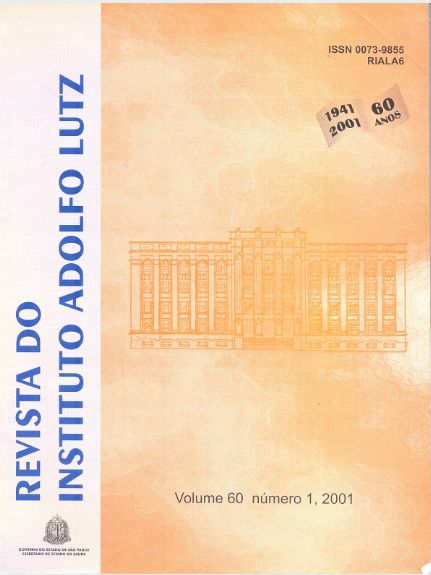Resumo
O flavivírus Iguape foi isolado pela primeira vez em 1979, a partir de camundongo sentinela, exposto em floresta no Município de Iguape, Estado de São Paulo, Brasil. Anticorpos inibidores da hemaglutinação, monotípicos para o vírus Iguape, foram detectados em animais domésticos e silvestres na Região do Vale do Ribeira, SP. Anticorpos monotípicos têm sido também detectados em soros humanos, embora não haja evidência de doença clínica. O estudo foi realizado em maio de 1994, no Município de Juquitiba, SP, em área de floresta. Mosquitos foram capturados com armadilhas luminosas. Após identificação sistemática, lotes de cerca de 30 mosquitos da mesma espécie foram processados para isolamento de vírus, empregando-se camundongos. A identificação foi realizada por testes de Hemaglutinação, Inibição de Hemaglutinação, Fixação de Complemento, Neutralização em camundongos e sensibilidade ao Desoxicolato de Sódio. Uma cepa de vírus (SPAr-158482) foi obtida a partir de mosquitos Anopheles (Kerteszia) cruzii. O agente isolado apresentou significante sensibilidade ao Desoxicolato de Sódio. A sorologia por Inibição de Hemaglutinação, Fixação de Complemento e Neutralização em camundongos, indicou que a cepa isolada é idêntica ao vírus Iguape. Esses achados sugerem que o An. cruzii pode desempenhar algum papel no ciclo de transmissão do vírus Iguape, em ambientes naturais.
Referências
1. Clarke, D.H.; Casals, J. Technique for hemagglutination and hemagglutination inhibition with arthropod-borne viruses. Am. J. Trop. Med. Hyg., 7: 561-573, 1958.
2. Coimbra, L.T.M. et al. Iguape: a newly recognized flavivirus from São Paulo State, Brazil. Intervirology, 36: 144-152, 1993.
3. Ferreira, I.B. et al. Surveillance of arbovirus infections in the Atlantic Forest region, State of São Paulo, Brazil. I. Detection of hemagglutination-inhibiting antibodies in wild birds between 1978 and 1990. Rev. Inst. Med. trop., 36: 265-274, 1994.
4. Figueiredo, L.T.M. et al. Identification of Brazilian flaviviruses by a simplified reverse transcription-polymerase chain reaction method using Flavivirus universal primers. Am. J. Trop. Med. Hyg., 59: 357-362, 1998.
5. Forattini, O.P. Entomologia Médica. 1ª ed. São Paulo - SP: Faculdade de Higiene e Saúde Pública, 1962.
6. Forattini, O.P. et al. Observações sobre atividade de mosquitos Culicidae em matas primitivas da planície e perfis epidemiológicos de vários ambientes no Vale do Ribeira, São Paulo, Brasil. Rev. Saúde Públ., São Paulo, 20: 178-203, 1986.
7. Forattini, O.P. et al. Freqüência ao ambiente humano e dispersão de mosquitos culicidae em área adjacente à Mata Atlântica primitiva da planície. Rev. Saúde Públ., São Paulo, 24: 101-107, 1990.
8. Forattini, O.P. et al. Studies on mosquitoes (Diptera: Culicidae) and anthropic environment. 1- Parity of blood seeking Anopheles (Kerteszia) in South-Eastern Brazil. Rev. Saúde Públ., São Paulo, 27: 1-8, 1993.
9. Fulton, F.; Dumbell, K.R. The serological comparison of strains of influenza virus. J. Gen. Microbiol., 3: 97-111, 1949.
10. Seto, M.I. Ocorrência de mosquitos (Diptera-Culicidae) em bromélias da localidade de Aldeia dos Índios, área endêmica de malária, no Município de Peruíbe (SP), no período de julho de 1985 a julho de 1987. São Paulo, 1992. [Dissertação de Mestrado - Instituto de Ciências Biomédicas da Universidade de São Paulo].
11. Shope, R.E.; Sather, G.E. Arboviruses In: Lennette, E.H.; Schmidt, N.J., eds. Diagnostic procedures for viral, rickettsial and chlamydial infections, 5th ed., Baltimore: American Public Health Association; 1979, p.767-814.
12. Theiler, M. Action of sodium desoxycholate on arthropod-borne viruses. Proc. Soc. Exp. Biol. Med., 96: 380-382, 1957.
13. Tikasingh, E.S.; Spence, L.; Down, W.G. The use of adjuvant and sarcoma 180 cells in the production of mouse hyperimmune ascitic fluids for arboviruses. Am. J. Trop. Med. Hyg., 15: 219-226, 1967.

Este trabalho está licenciado sob uma licença Creative Commons Attribution 4.0 International License.
Copyright (c) 2001 Esther Luiza Bocato-Chamelet, Terezinha Lisieux Moraes Coimbra, Elza da Silva Nassar, Luiz Eloy Pereira, Ivani Bisordi Ferreira, Luiza Terezinha Madia de Souza, Akemi Suzuki
